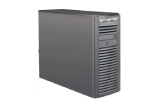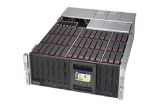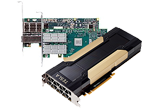ソフトウェア
OpenMX
OpenMXは、東京大学の尾崎研究グループらが開発・維持している密度汎関数理論(DFT)、ノルム保存型擬ポテンシャル、擬原子基底関数に基づいた、幅広いナノスケール素材のシミュレーション計算を行うためのプログラムです。並列コンピュータに対して特に入念に設計されていて、数千コアを有する並列コンピュータを使用すれば、一万個以上の原子から構成される系の非経験的(ab initio)電子状態計算も実行可能です。フリーソフトウェアであり、GNU GPLライセンスに基づいて無償で配布されています。
Status
http://www.openmx-square.org/whatsnew/whatsnew.html
OpenMX Ver 3.8 (with user’s manual) was released.
The main features of the development are as follows:
(1) Unfolding method for band structures (supported by C.-C. Lee and T. Ozaki)
In OpenMX Ver. 3.8, an unfolding method for band structures is released, of which implementation details is found in J. Phys.: Condens. Matter 25, 345501 (2013). When the band structure of a system with imperfection such as surfaces, impurities, vacancies, and structural distortion calculated by the supercell approach is compared to spectrum measured by Angle-Resolved Photoemission Spectroscopy (ARPES), the experimentally measured periodicity of the system is generally different from that of the supercell we introduced for the calculation. OpenMX provides a method for unfolding the band structure of the supercell into the Brillouin zone of a reference unit cell that a user specifies in the input file. The functionality is supported for not only collinear, but also non-collinear DFT calculations. Related information can be found in the manual.
(2) DFT-D3 method for vdW interaction (supported by M. Ellner and R. Perez)
The DFT-D3 method by Grimme et al. (J. Chem. Phys. 132, 154104 (2010)) is supported to include a vdW interaction as well as the DFT-D2 method (J. Comput. Chem. 27, 1787 (2006)). The usage of the functionality can be found in the manual.
(3) Analysis of real-space charge/spin current density (supported by M. Kawamura, K. Yoshimi, and T. Ozaki)
OpenMX Ver. 3.8 supports a tool to analyze how charge and spin current flow in real space by calculating the real-space charge and spin current density. The usage of the functionality can be found in the manual. Also the technical notes on the implementation can be found in here.
(4) Analysis of eigenchannels for electric transport (supported by M. Kawamura, K. Yoshimi, and T. Ozaki)
OpenMX Ver. 3.8 provides an analysis tool to investigate how charge and spin current flow through eigenchannels of transmission. The usage of the functionality can be found in the manual. Also the technical notes on the implementation can be found in here.
(5) Variable cell optimization (supported by Y. Shiihara and T. Ozaki)
Variable cell optimizations with/without constraints are available in OpenMX Ver. 3.8. Not only full optimization for cell vectors and internal coordinates, but also constraint optimization for the cell shape are supported. The usage of the functionality can be found in the manual.
(6) Initial approximate Hessian (supported by T. Ozaki)
OpenMX Ver. 3.8 supports an initial approximate Hessian, proposed by Schlegel (Theoret. Chim. Acta (Berl.) 66, 333 (1984); J. Mol. Struc. (Theochem) 398-399, 55 (1997)), for the RF and EF optimizers in the geometry and variable cell optimizations. The initial approximate Hessian may substantially accelerate the convergence compared to the simplest initial approximate Hessian of the identity. The usage of the functionality can be found in the manual.
(7) Orbitally decomposed total energy (supported by T. Ozaki)
OpenMX Ver. 3.8 provides a useful tool which decomposes the total energy into each contribution associated with each basis function, where the decomposition is performed based on projection onto basis functions. The usage of the functionality can be found in the manual.
(8) ScaLAPACK version of OpenMX (supported by T.V.T. Duy)
It is possible to enhance the performance of OpenMX using ScaLAPACK, PBLAS, and BLACS. The performance improvement will be obtained in terms of not only computational speed, but also memory usage when ‘Cluster’ and ‘Band’ for the keyword ‘scf.EigenvalueSolver’ is employed for large-scale systems including more than 500 atoms. The usage of the functionality can be found in the here and here
(9) Natural population analysis (supported by T. Ohwaki)
In the natural bond orbital (NBO) method developed by Weinhold et al. (Chem. Rev. 88, 899 (1988); WIREs Comput. Mol. Sci. 2, 1 (2012)), atomic population (or atomic charge) is calculated based on atomically localized orbitals, natural atomic orbitals (NAO), which is referred to as natural population (NP). OpenMX supports the NP analysis. Especially, for large-sized calculation models, one can efficiently calculate and analyze NPs by selecting target atoms, which is an original scheme based on a truncated cluster method (J. Chem. Phys. 140, 244105 (2014)). The usage of the functionality can be found in the manual
(10) Open core pseudopotentials (supported by T. Ozaki)
The 4f-states in lanthanide elements are spin-polarized in many cases, and the majority states are located at below a few eV taken from the Fermi level. However, LDAs and GGAs cannot describe the feature of band structures for those materials. Although one way is to perform the plus U method by introducing on-site Coulomb repulsion for the 4f-states in such a case, OpenMX Ver. 3.8 provides a simpler way that the spin-polarizaion of 4f-states is taken into account via a pseudopotential, so-called open core pseudopotential, while a few open core pseudopotentials are available in the database Ver. 2013. The usage of the functionality can be found in the manual.
(11) Interface with Wannier90 (supported by Y.P. Mizuta and F. Ishii)
OpenMX Ver. 3.8 interfaces with Wannier90 (http://www.wannier.org/) which constructs maximally localized Wannier functions, and calculates physical properties such as Wannier projected DOS and bandstructure, Fermi surface, Berry phase related properties (anomalous Hall conductivity, optical conductivity, and orbital magnetization), and thermoelectric properties. The usage of the functionality can be found in the manual.
(12) Constraint DFT for non-collinear spin orientation (supported by T. Ozaki)
OpenMX Ver. 3.8 supports a constraint scheme (scf.Constraint.NC.Spin=on2) in the non-collinear calculation that the spin direction and the magnitude of the spin moment are constrained at the initial setting by the keyword ‘Atoms.SpeciesAndCoordinates’. The usage of the functionality can be found in the manual.
(13) Voronoi volume (supported by T. Ozaki)
The Voronoi volume which is a volume of the Voronoi polyhedron is provided in OpenMX Ver. 3.8 as a supplemental information during the Voronoi charge analysis. The usage of the functionality can be found in the manual.
(14) DIISH mixing for Hamiltonian (supported by T. Ozaki)
RMM-DIIS for Kohn-Sham Hamiltonian (DIISH) is supported in OpenMX Ver. 3.8, which may be useful to accelerate the SCF convergence for the LDA+U calculations. The usage of the functionality can be found in the manual.
(15) Controling of spin-orbit coupling strength (supported by T. Ozaki)
In OpenMX Ver. 3.8, it is possible to contol the spin-orbit coupling strength using a conventional pseudopotential stored in the database Ver. 2013 without generating a special pseudopotential with a larger or smaller spin-orbit coupling. The usage of the functionality can be found in the manual.
(16) ‘make all’ (supported by T. Ozaki)
All the executable files including post-processing codes can be compiled. The usage of the functionality can be found in the manual.
(17) md2axsf (supported by T. Ozaki)
In molecular dynamics simulations or geometry optimization, ‘System.Name.md’ is generated to save a series of structural change. Although ‘System.Name.md’ being the xyz format can be read in xmakemol and XCrySDen, the copied cell in periodic systems cannot be displayed. For such a purpose, a small post processing code is available to convert the format from ‘xyz’ to ‘axsf’. The usage of the functionality can be found in the manual.
(18) ‘level.of.stdout 0’ (supported by T. Ozaki)
For the standard output the minimum information is output by specifying ‘level.of.stdout 0’, which will be useful for long time molecular dynamics simulations.
(19) Bugs fixed
Minor bugs in OpenMX Ver. 3.7 were fixed.
(20) Manual revised
The manual of OpenMX was revised.
お問い合わせ
平日9:30~17:30 (土曜日、日曜日、祝祭日、年末年始、夏期休暇は、休日とさせていただきます。)








